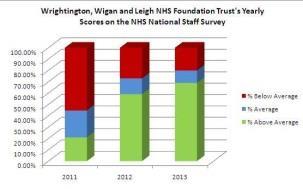The ‘WWL Way’ has emerged from a series of initiatives to empower staff at Wrightington, Wigan and Leigh Foundation Trust. Nicole Ferguson explains how it works

Wrightington, Wigan and Leigh Foundation Trust serves a population of 318,000 based in the north west of Greater Manchester. It supports 539 inpatient beds, employs 4,500 staff and invests more than £200m a year in a range of general and specialist acute services.
The board feels that “if we get it right for our staff, we get it right for our patients”. Staff engagement and empowering every worker to make their own decisions in their own area of work and expertise will realise greater benefits than top-down generic managerial interventions.
In 2011 our poor staff survey results were the catalyst for prioritisation and greater investment in staff engagement.
Going walkabout
The staff engagement journey at the trust began more than 15 years ago. Staff Involvement Delivers was a partnership initiative jointly developed by human resources and staff.
The concept was simple: we needed staff to be engaged with what was happening within the trust. Our “Conversations With” directors events enabled staff to raise issues important to them, and the host director to immediately respond.
“Walkabouts” also gave directors the opportunity to integrate with staff at the front line, and gave employees regular opportunities to talk directly with the senior team.
Safe space
By expanding our outreach work, we ensured staff were involved in wider decisions and felt safe to contribute ideas. This freedom to influence at all levels has been empowering for staff, and has released new energy into the organisation. We kept the topics and format of the outreach work as broad as possible in the first instance so as to not restrict the range of subjects pertinent to staff.
Staff Involvement Delivers helped us to establish a partnership of openness and transparency by getting staff on board with difficult decisions and change, and meeting challenges.
In recent years, we have further encouraged staff engagement through the Listening into Action programme. This included large scale staff listening events, led by trust chief executive Andrew Foster and other directors. Staff were asked three questions: What works well? What needs to improve? What are the barriers to improvement?
These events gave us the focus to achieve quick wins and make bigger system changes, aligned to the needs of staff.
‘Teams are encouraged to come together for 15 minutes a day to discuss their priorities, give updates, address issues and celebrate success’
Listening into Action also initiated our “pioneer teams” programme, which aims to embed staff engagement at team level with staff running their own listening events and implementing local level changes to improve services.
In parallel, we have further strengthened our staff engagement culture through our partnership with logistics group Unipart. It helped us to develop lean ways of working through team communication cells, visual management tools and a strong emphasis on metrics and devolved problem solving.
Teams are encouraged to come together for 15 minutes a day to discuss their priorities, give updates, address issues and celebrate success. They also record their progress visually at a central point visible to the whole team.
We have now combined these three different but complementary approaches into our own unique brand of staff engagement called “the WWL Way”. We have learnt many lessons on this journey.
Six steps to good staff engagement
- Establish a partnership approach between the staff side and management, working together towards mutual staff engagement goals.
- Strong visibility and promotion of staff engagement initiatives, with senior leaders’ commitment and sponsorship, and acting “at scale”.
- Measuring and monitoring staff engagement levels and the linked improvements to service delivery, so that staff can see progress and we can evaluate success.
- Acting and communicating quickly following listening events. Provide regular feedback to staff about the suggestions you have responded to and what achievements have been made through a “you said, we did” approach.
- Acknowledge that staff engagement can be enabled in many ways, from the way you recognise and value staff, to the way you involve staff in decisions, and how you build motivation and morale.
- Always ask the question “have we asked our staff?” We no longer assume we know the answers and we often hear from staff keen to share novel solutions. We are seeing a cultural shift from our leadership, in that leaders are beginning to make more informed and collaborative decisions with greater staff involvement.
The impact of Wrightington, Wigan and Leigh’s staff engagement initiative is clear to see in the graph below, which shows the trust’s recent staff survey results.

In addition to improvements in our survey scores, there has been a significant reduction in sickness absence (from 4.62 per cent in April 2012 to 4.17 per cent in December 2013) and spending on temporary staffing (from £15m in 2011-12 to £12m in 2012-13). These improvements have been sustained and we are confident they will continue.
Taking the pulse
The future of staff engagement at the trust is bright and multidimensional. We are now measuring several factors to better understand what enables improved staff engagement, including:
- Working relationships – do staff feel supported by managers and colleagues?
- Recognition – do staff feel recognised and valued?
- Resources – do they have the resources they need to work effectively?
- Clarity – do staff clearly understand their role and what is going on in their team and the trust?
- Perceived fairness – do staff feel policies, processes and treatment is fair?
- Personal development – do people have opportunities to develop and use their strengths?
- Influence – do they feel involved in change and decisions?
- Mindset – do staff feel proud, positive and optimistic about the future?
This framework provides a structure for understanding staff engagement more deeply. We use feedback from our staff “pulse check” surveys and listening events to focus our efforts in the right places, and respond to ever changing staff engagement needs.
‘We want staff to find and promote new and innovative ways to improve engagement, with support and advice at every step in their journey’
For example, we are currently exploring with staff how we can improve recognition and reward. We are also using the framework to identify specific staff engagement issues within teams, through the staff engagement pioneer teams programme. We know that different teams have different needs, so our staff engagement toolkit offers teams a choice of solutions to apply locally.
We know that we need to continually develop and refine our approach, to keep things interesting and continually improve. The WWL Way toolkit is growing beyond what Staff Involvement Delivers, Listening into Action and Unipart have given us. We want staff to find and promote new and innovative ways to improve engagement, with support and advice at every step in their journey.
We have recently launched six new values, developed through conversations with staff, as part of a wider strategy for organisational development. We are now aligning staff engagement to these new values, in particular “teamwork”.
Staff engagement takes time and investment, and above all needs active participation from senior leaders. However, given the right attention, simple engagement initiatives can lead to great service improvements that benefit staff and patients.
Nicole Ferguson is staff engagement lead at Wrightington, Wigan and Leigh Foundation Trust, which won the HSJ Award 2013 for staff engagement



























No comments yet